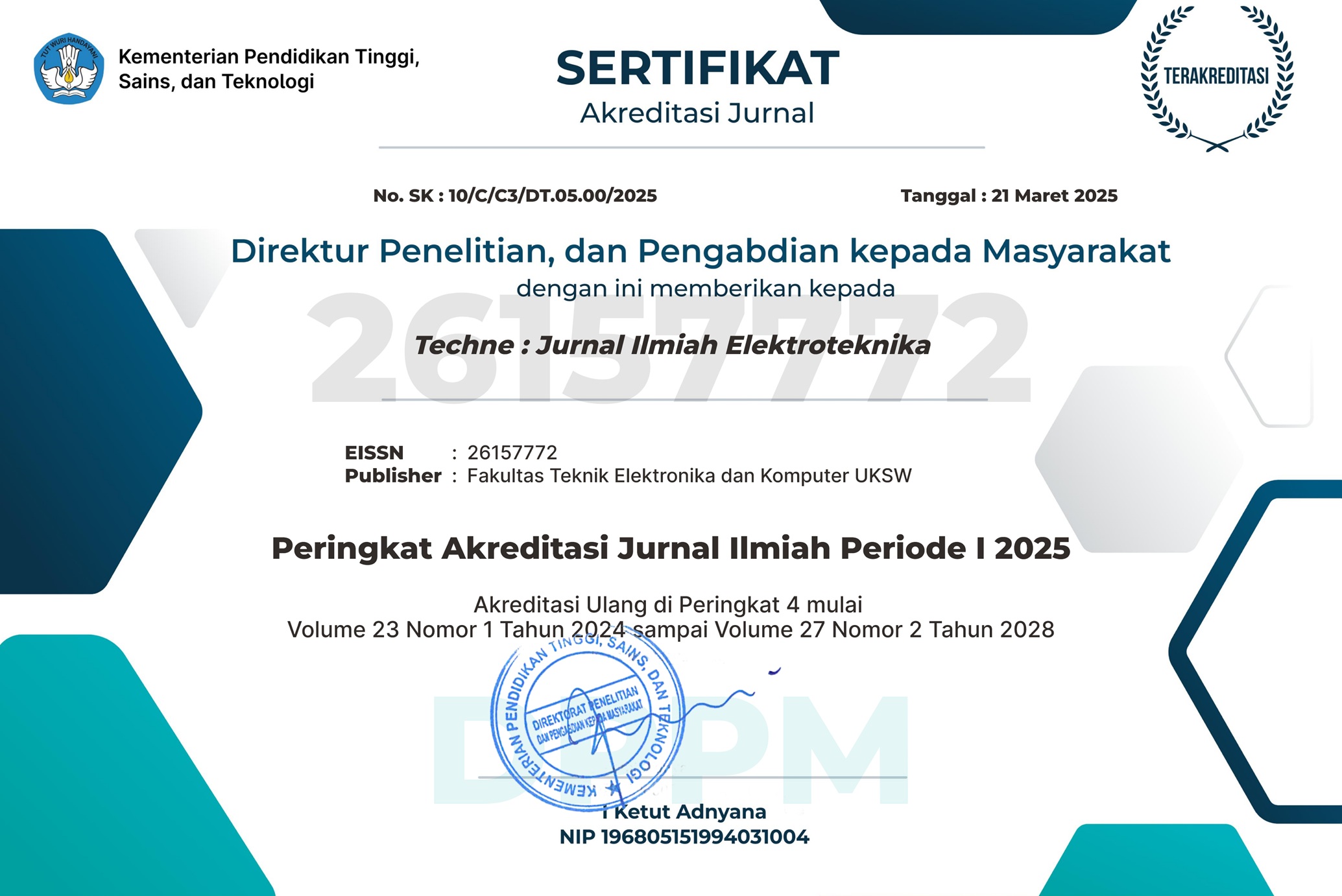Eye Detection System Based on Image Processing for Vehicle Safety
DOI:
https://doi.org/10.31358/techne.v19i01.225Keywords:
Image processing, Viola-Jones, Eye DetectionAbstract
The more advanced the technology and the greater the community's need to carry out activities every day, the number of vehicles on the highway is getting crowded. From year to year, the greater the level of traffic accidents caused by many factors, among the usual reasons is the loss of awareness of the driver when driving a vehicle especially drowsiness. One of the drowsiness parameters is the frequency eye blinks. Therefore, to get the drowsiness symptoms, the purpose of this research is to detect the eye blinks, which in turn reduce the level of accidents by detecting sleepy eyes based on digital image processing. The method used to detect both eyes is the Viola-Jones method. The detection of both eyes can also acquire the duration of closed eyes and the number of eye blinks. A person can be said to be sleepy by means of sleepiness parameters determined by a study. The research shows that detection of eye blinks using the Viola-Jones method has a fairly high accuracy of up to 84.72% if the face condition is upright and tilted no more than 45 degrees. Another conclusion is that eye detection and driver detection are more effective at certain light intensity values which are around 2-33 lux.
Downloads
References
[2] B. P. Statistik, “Jumlah Kecelakaan, Koban Mati, Luka Berat, Luka Ringan, dan Kerugian Materi yang Diderita Tahun 1992-2018,” 2019. [Online]. Available: https://www.bps.go.id/linkTableDinamis/view/id/1134. [Accessed: 14-Mar-2019].
[3] M. Hafil, “Jumlah Kecelakaan di Indonesia Empat Tahun Terakhir,” 2018. [Online]. Available: https://nasional.republika.co.id/berita/nasional/umum/17/05/02/opaywe326-jumlah-kecelakaan-di-indonesia-empat-tahun-terakhir. [Accessed: 03-Apr-2018].
[4] S. Dhiraj Sunehra and K. Jhansi, “Implementation of Microcontroller Based Driver Assistance and Vehicle Safety Monitoring System,” in 2015 International Conference on Information Processing (ICIP), pp. 423–428, 2015.
[5] P. Chaisiriprasert and K. Yongsiriwit, “Surveillance System for Abnormal Driving Behavior Detection,” in 2019 4th International Conference on Information Technology (InCIT), pp. 155–158, 2019.
[6] J. P. Vasconez and F. A. Cheein, “Sleepiness Detection for Cooperative Vehicle Navigation Strategies,” in 2018 5th International Conference on Control, Decision and Information Technologies (CoDIT), pp. 940–945, 2018.
[7] D. Mashru, “Detection of a Drowsy state of the Driver on road using wearable sensors?: A survey,” in 2018 Second International Conference on Inventive Communication and Computational Technologies (ICICCT), pp. 691–695, 2018.
[8] Y. Ma, S. Qi, L. Fan, W. Lu, C. Chan, and Y. Zhang, “Dynamic Bayesian Network Approach to Evaluate Vehicle Driving Risk Based on On-Road Experiment Driving Data,” IEEE Access, vol. 7, pp. 135050–135062, 2019.
[9] T. Teng and L. Bi, “A Novel EEG-based Detection Method of Emergency Situations for Assistive Vehicles,” in Seventh International Conference on Information Science and Technology, pp. 335–339, 2017.
[10] S. Ríos-aguilar, J. Luis, M. Merino, A. M. Sánchez, and Á. Sánchez, “Variation of the Heartbeat and Activity as an Indicator of Drowsiness at the Wheel Using a Smartwatch,” Int. J. Interact. Multimed. Artif. Intell., vol. 3, no. 3, pp. 96–100, 2015.
[11] S. Samson and A. S. Oliver, “Analyzing Abnormalities While Driving To Avoid Accidents,” in 2019 Fifth International Conference on Science Technology Engineering and Mathematics (ICONSTEM), vol. 1, pp. 187–191, 2019.
[12] S. Nanda, “An IOT Based Smart System for Accident Prevention and Detection,” in 2018 Fourth International Conference on Computing Communication Control and Automation (ICCUBEA), pp. 1–6, 2018.
[13] C. Mohamedaslam, T. A. Roshan, M. T. M. Sahal, N. A. Najeeb, and K. Nisi, “A Smart Vehicle for Accident Prevention Using Wireless Blackbox and Eyeblink Sensing Technology Along with Seat Belt Controlled Ignition System,” in 2016 Online International Conference on Green Engineering and Technologies (IC-GET) A, 2016.
[14] M. D. Putro, T. B. Adji, and B. Winduratna, “Sistem Deteksi Wajah dengan Menggunakan Metode Viola-Jones,” in Seminar Nasional Science, Engineering, and Technology, pp. 1–5, 2012.
[15] I. Chatterjee and A. Sharma, “Driving Fitness Detection?: A Holistic Approach For Prevention of Drowsy and Drunk Driving using Computer Vision Techniques,” in 2018 South-Eastern European Design Automation, Computer Engineering, Computer Networks and Society Media Conference (SEEDA_CECNSM), pp. 1–6, 2018.
[16] E. P. Poli, A. S. M. Lumenta, B. A. Sugiarso, and J. O. Wuwung, “Deteksi Rasa Kantuk pada Pengendara Kendaraan Bermotor Berbasis Pengolahan Citra Digital,” J. Tek. Elektro dan Komput., vol. 2, no. 2, pp. 1–6, 2013.
[17] A. S. Houssaini, “Real-Time Driver ’ s Hypovigilance Detection using Facial Landmarks,” in 2019 International Conference on Wireless Technologies, Embedded and Intelligent Systems (WITS), pp. 1–4, 2019.
[18] I. Hedrian, M. Rivai, and D. Purwanto, “Implementasi Stimulus Aromatik Pada Pengemudi Berdasarkan Deteksi Kantuk,” Institut Teknologi Sepuluh November, 2012.
[19] A. Das, A. Ray, A. Ghosh, and S. Bhattacharyya, “Vehicle Accident Prevent cum Location Monitoring System,” in 2017 8th Annual Industrial Automation and Electromechanical Engineering Conference (IEMECON), pp. 101–105,2017.
[20] P. Viola, “Rapid Object Detection using a Boosted Cascade of Simple Features,” in Proceedings of the 2001 IEEE Computer Society Conference on Computer Vision and Pattern Recognition. CVPR 2001, 2001.








